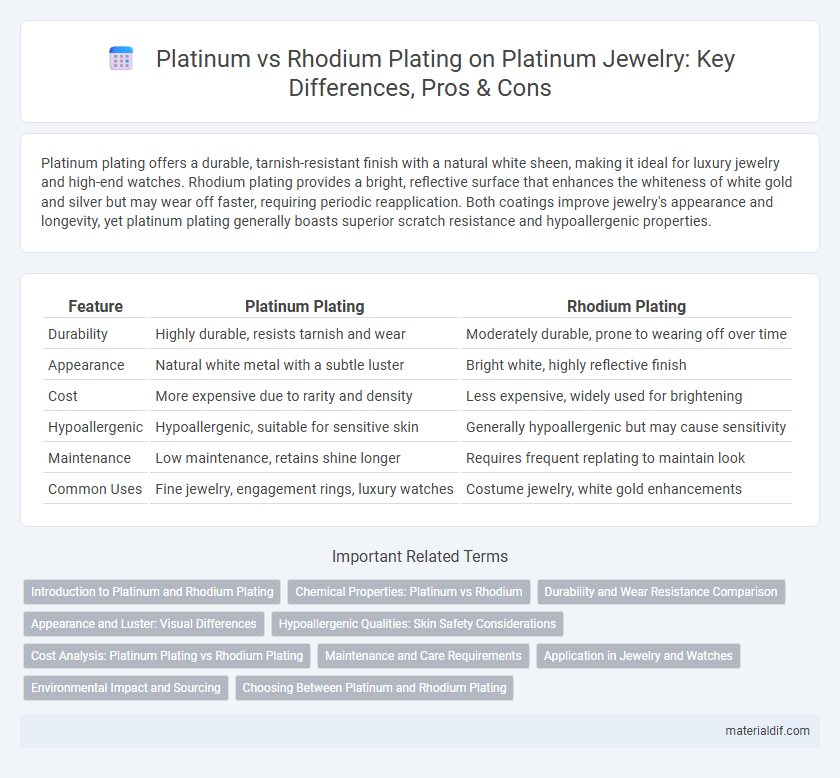Platinum plating offers a durable, tarnish-resistant finish with a natural white sheen, making it ideal for luxury jewelry and high-end watches. Rhodium plating provides a bright, reflective surface that enhances the whiteness of white gold and silver but may wear off faster, requiring periodic reapplication. Both coatings improve jewelry's appearance and longevity, yet platinum plating generally boasts superior scratch resistance and hypoallergenic properties.
Table of Comparison
| Feature | Platinum Plating | Rhodium Plating |
|---|---|---|
| Durability | Highly durable, resists tarnish and wear | Moderately durable, prone to wearing off over time |
| Appearance | Natural white metal with a subtle luster | Bright white, highly reflective finish |
| Cost | More expensive due to rarity and density | Less expensive, widely used for brightening |
| Hypoallergenic | Hypoallergenic, suitable for sensitive skin | Generally hypoallergenic but may cause sensitivity |
| Maintenance | Low maintenance, retains shine longer | Requires frequent replating to maintain look |
| Common Uses | Fine jewelry, engagement rings, luxury watches | Costume jewelry, white gold enhancements |
Introduction to Platinum and Rhodium Plating
Platinum plating offers exceptional durability, corrosion resistance, and a naturally white, lustrous finish highly valued in fine jewelry and industrial applications. Rhodium plating, derived from a rare and reflective metal, provides an ultra-bright, mirror-like surface that enhances whiteness and protects underlying metals from tarnish and scratches. Both plating options are prized for improving metal longevity, but platinum plating is favored for its stable, heavier coating, while rhodium plating is commonly used for a thinner, more reflective finish.
Chemical Properties: Platinum vs Rhodium
Platinum exhibits exceptional chemical stability, resisting oxidation and corrosion in most environments, with a melting point of 1768degC and atomic number 78. Rhodium, atomic number 45, is more chemically inert than platinum and boasts a higher melting point of 1964degC, making it highly resistant to acids and high temperatures. Both metals belong to the platinum group but differ in oxidation states and catalytic properties, with rhodium often used as a protective plating due to its superior hardness and reflectivity.
Durability and Wear Resistance Comparison
Platinum plating offers exceptional durability and high resistance to tarnishing, making it ideal for long-lasting jewelry and industrial applications. Rhodium plating, known for its brilliant white finish, provides superior hardness and wear resistance, especially valuable in protecting white gold and silver from scratches and corrosion. While Rhodium typically outperforms Platinum in hardness and scratch resistance, Platinum's corrosion resistance and longevity ensure lasting value in environments with heavy wear.
Appearance and Luster: Visual Differences
Platinum plating offers a naturally white, silvery appearance with a soft, subtle luster that enhances elegance and sophistication. Rhodium plating, in contrast, provides a much brighter, mirror-like finish with a stark white brilliance, often used to maximize shine and reflectivity. While platinum's finish matures gracefully over time with a slight patina, rhodium maintains a high-gloss, reflective surface that resists tarnishing but may require periodic reapplication to sustain its intense brightness.
Hypoallergenic Qualities: Skin Safety Considerations
Platinum plating is renowned for its exceptional hypoallergenic properties, making it an ideal choice for sensitive skin compared to rhodium plating, which can sometimes cause irritation due to alloy components. The pure and inert nature of platinum reduces the risk of allergic reactions, providing superior skin safety for jewelry wearers. In contrast, rhodium plating often requires periodic reapplication as it tends to wear off, potentially exposing underlying metals that provoke sensitivities.
Cost Analysis: Platinum Plating vs Rhodium Plating
Platinum plating typically costs more than rhodium plating due to the higher market price of platinum, which ranges around $1,000 per ounce compared to rhodium's volatile pricing that can exceed $10,000 per ounce. The durability and tarnish resistance of platinum justify its premium, making it preferable for long-lasting luxury items despite the initial expense. Rhodium plating remains a cost-effective choice for bright, reflective finishes, but its thin layers may require frequent re-plating, increasing total maintenance costs over time.
Maintenance and Care Requirements
Platinum plating offers superior durability and resistance to tarnish, requiring minimal maintenance compared to rhodium plating, which tends to wear off faster and demands more frequent reapplication. Regular gentle cleaning with a mild soap and soft cloth is recommended for both, but rhodium-plated jewelry needs extra attention to avoid harsh chemicals that can accelerate fading. Maintaining platinum plating's luster is easier over time, making it a preferred choice for long-lasting elegance and low upkeep.
Application in Jewelry and Watches
Platinum plating offers exceptional durability and a naturally white luster that resists tarnish, making it ideal for high-end jewelry and luxury watches. Rhodium plating provides a brighter, more reflective finish with superior scratch resistance but may require re-plating over time due to wear. Jewelers often choose platinum for its lasting prestige and hypoallergenic properties, while rhodium is preferred for enhancing the brilliance of white gold and silver pieces.
Environmental Impact and Sourcing
Platinum plating involves mining platinum group metals, which often results in significant environmental disruption due to energy-intensive extraction and chemical use, while rhodium plating, sourced primarily as a byproduct of platinum and nickel mining, typically benefits from reduced additional mining impact. Rhodium's rarity and extreme hardness demand less frequent replating, potentially lowering long-term environmental footprint compared to platinum's softer nature requiring more maintenance. Both metals face ethical sourcing challenges, but rhodium's limited availability makes sustainable sourcing critical to minimizing ecological harm and ensuring industry accountability.
Choosing Between Platinum and Rhodium Plating
Platinum plating offers exceptional durability and natural white luster, making it ideal for high-end jewelry that requires long-lasting brilliance and hypoallergenic properties. Rhodium plating provides a highly reflective, bright white finish and excellent resistance to tarnish, often used to enhance the appearance of white gold and silver. When choosing between platinum and rhodium plating, consider factors such as budget, desired longevity, maintenance requirements, and the specific metal underneath to achieve optimal results.
Platinum vs Rhodium Plating Infographic

 materialdif.com
materialdif.com